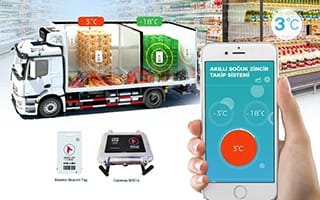INTELLI TEXTILE | RFID TEXTILE SYSTEMS
RFID Solution from Production to Sales in Textile Industry!
In textiles, we use RFID technology in production, inventory control, warehousing, distribution, logistics, automated object tracking and supply chain management.
RFID TEXTILE TRACKING SYSTEM
GENERAL FEATURES OF THE SYSTEM
The RFID textile system enables textile products to be tracked and managed using an RFID reader, RFID tags and a software tool. RFID tags are placed on the products. Usually these tags are washable and sewable. The RFID textile system is used to display the shelf where the products are located, quantities and other information. It also makes it easier to manage stocks. In addition to all these, brand manufacturers use RFID textile systems to identify their original products. It can be especially useful in supply chain management and inventory control, as it allows companies to quickly and accurately track the movement of products along the supply chain and identify potential bottlenecks or problems.
With the RFID textile system, tracking and managing products becomes less costly.
With the textile system, tracking and managing products becomes faster and more accurate. In this way, processes take less time and fewer mistakes are made.
The RFID textile system allows you to keep track of what stage textile products are at and where they are located. In this way, you can track when the products will be in stock, when they will be delivered and which products are in which store.
Customers can find and receive the products they want more quickly and accurately. This increases customer satisfaction.
By tracking and managing products with the RFID system, you can better manage stock quantities.
How does the RFID TEXTILE TRACKING SYSTEM work?
- RFID Tags: Each textile product or fabric is implanted with a unique RFID tag or chip. These tags contain the product’s unique ID and related data.
RFID Readers: The textile tracking system includes RFID readers placed at various points in the enterprise. These readers are used to detect RFID tags and read the information on the tags.
Track and Trace: The movements and locations of the products are tracked thanks to RFID tags. For example, a textile product can be tracked from the production line to the warehouse, from the warehouse to the store, from the store to the customer.
Advantages of the System
Real Time Monitoring
The system can track the real-time location and status of objects.
Accurate Counting
It performs accurate and precise counting of thousands of objects and verifies the detection of human errors.
Fast Collection and Shipping
Fast processing in storage and distribution centers.
Sustainability
RFID tags use less material than traditional barcode labels and are reusable.
Data Analytics
Large amounts of data can be quickly collected and analyzed to improve business processes.
Areas of Use
RFID textile systems are used in the textile industry as the name suggests. This system is used in workshops, factories and stores.
Sources
OTHER SOLUTIONS
PERSONNEL TRACKING SYSTEM
A staff tracking system is a software or hardware-based system used to track the attendance, location and effectiveness of employees in an organization. It can be used to manage time and attendance, record absences and track employee productivity.
Other Content
Keep following us to be informed about all developments in the field of RFID and IoT. New information and new solutions coming soon…
Why Should RFID Be Used in Cold Chain Transportation?
In Cold Chain Transportation, RFID technology plays a crucial role in maintaining appropriate temperature conditions, especially for perishable goods. RFID (Radio Frequency Identification) technology provides significant advantages in this process:

Temperature Monitoring: RFID tags equipped with temperature sensors continuously track temperature fluctuations. This feature offers an effective solution for maintaining quality and freshness economically.
Data Accuracy and Traceability: RFID tags securely store and transmit data, ensuring reliable traceability throughout the cold chain. This enhances compliance and strengthens the overall cold chain integrity.
Process Automation: RFID technology automates processes related to warehouse management, product continuity, and quality control. This leads to increased efficiency and cost savings.
Enhanced Security: RFID tags provide security against threats such as tampering and unauthorized access. They prevent interference with the tags, ensuring maximum product safety.
Exception Management: RFID technology detects deviations in temperature or other critical metrics, triggering real-time alerts. This helps prevent spoilage and facilitates prompt action.
Features of RFID Temperature Sensors
Teknopalas’ specialized RFID and NFC tags offer unique features for maintaining the cold chain:
Lightweight and Compact Design: The tags are only 1 mm thick and can be designed as either a shipping label or a card.
Adjustable Logging Intervals: Temperature recording intervals, alarm levels, and similar parameters can be customized for each tag and updated as needed.
High Data Storage Capacity: Temperature data can be stored offline within the chip and accessed easily via the cloud.
Multiple Reading Methods: Users can read temperature logs using fixed readers, handheld readers, or NFC-enabled smartphones.
Long Battery Life: The system optimizes and adjusts the battery life of the tags to meet specific requirements.
Wide Temperature Recording Range: The tag records temperatures from -30°C to +50°C with ±0.25°C accuracy.
Ease of Tracking with Mobile App and NFC
Teknopalas RFID and NFC tags enable user-friendly cold chain tracking through a mobile application. By loading temperature data onto the app, users can monitor temperature changes from anywhere. Additionally, temperature data can be accessed seamlessly by tapping NFC-enabled phones to the tags.

Cloud-Based Data Integration
Our RFID and NFC tags provide options for temperature tracking, offline storage, and cloud uploading. This allows office staff to monitor the cold chain remotely, improving storage management. At Teknopalas, we offer businesses highly secure, accurate, and continuous monitoring systems with solutions such as RFID cold chain tracking and NFC cold chain monitoring. By ensuring reliable and efficient solutions with our RFID tags, we enhance success in cold chain logistics.
RFID Usage in the Shoe Industry
RFID is a technology that uses electromagnetic fields to automatically identify and track tags attached to objects. RFID usage in the shoe industry, used to improve inventory management, supply chain visibility and consumer experiences.
Improving Inventory Management
RFID technology enables real-time tracking of footwear inventory throughout the supply chain. By placing RFID tags in shoe boxes or directly inside shoes, manufacturers and retailers track the movement of each product from production to point of sale. This facilitates accurate inventory counts and reduces stock outs. This minimizes overstock situations, leading to increased operational efficiency and cost savings.
Streamlining Supply Chain Operations
The RFID application offers unparalleled visibility across the supply chain. This allows stakeholders to pinpoint the exact location of shoes at any given time. This visibility enables better decision-making on production schedules, shipping routes and inventory replenishment. In addition, RFID enables the detection of counterfeit goods and unauthorized diversions. This helps protect brand reputation and ensure product authenticity throughout the supply chain.

Enhanced Consumer Experiences
For consumers, RFID technology enhances the shopping experience by providing access to detailed product information and personalized recommendations. RFID-enabled smart shelves and interactive displays allow shoppers to quickly find desired shoe styles, view product specifications and access complementary items or accessories. In addition, RFID-enabled loyalty programs and mobile applications enable consumers to receive customized promotions and discounts, encouraging brand loyalty and repeat purchases.
Ensuring Data Security and Confidentiality
Despite its numerous benefits, the widespread adoption of RFID technology raises concerns about data security and privacy. To address these concerns, stakeholders need to implement strong encryption protocols and access controls to protect sensitive information stored on RFID tags. In addition, open communication and transparency regarding data collection practices is crucial to build trust among consumers and comply with regulatory requirements.
As a result, RFID technology offers the footwear industry improved inventory management and supply chain visibility. It also offers significant benefits, including improved consumer experiences. However, stakeholders need to ensure that RFID technology is implemented responsibly in industry operations, prioritizing data security and privacy. By using RFID effectively, it continues to innovate and meet the demands of consumers in a digitized world.
RFID Usage in the Leather Industry
The use of RFID technology has emerged as a game changer in various sectors, including the leather industry. RFID Usage in the Leather Industry increases the efficiency, traceability and overall management of leather products throughout the supply chain.
Advanced Inventory Management
RFID tags embedded in leather goods enable precise tracking of inventory in production and distribution. This technology facilitates real-time monitoring of stock levels, reducing the possibility of stock-outs or overstocking. Manufacturers optimize inventory levels with RFID. This allows them to streamline production processes and increase overall operational efficiency.
Enhanced Traceability and Quality Control
RFID enables seamless traceability of leather products from origin to the end consumer. The RFID tag contains identifiers that can be linked to detailed product information such as origin, processing methods and quality certificates. This level of traceability not only increases consumer confidence, but also facilitates quality control measures, allowing manufacturers to quickly identify and resolve problems.

Streamlined Supply Chain Management
RFID technology facilitates the automation of various supply chain processes, resulting in greater efficiency and cost savings. Furthermore, by accurately tracking the movement of materials, semi-finished and finished products, RFID enables better coordination between different stakeholders in the supply chain. In addition, RFID-enabled systems automatically generate shipping and receiving documents, reducing paperwork and minimizing errors.
Advanced Brand Protection
Counterfeiting and product diversion pose significant challenges for the leather industry. RFID technology authenticates genuine products and detects unauthorized distribution channels. This provides a robust solution for brand protection. By implementing RFID-enabled anti-counterfeiting measures, leather manufacturers protect their brand reputation and consumer trust.
Solution
The adoption of RFID technology is revolutionizing the leather industry by improving efficiency, traceability and overall supply chain management. As the technology continues to evolve, its integration into leather production processes will become increasingly widespread. This will lead to greater innovation and competitiveness in the industry. Adopting RFID represents a significant opportunity for leather manufacturers to achieve operational excellence while meeting the demands of an increasingly discerning market.





